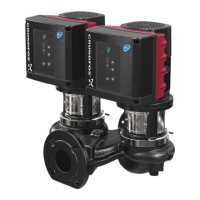English (US)
38
15.16 Monitoring functions
15.16.1 Limit-exceeded function
This function can monitor set limits of analog values. It will react if
the values exceed the limits. Each limit can be set as a maximum
or minimum value. For each of the monitored values, you must
define a warning limit and an alarm limit.
The function makes it possible to monitor two different locations
in a pump system at the same time. For instance the pressure at
a consumer and the pump discharge pressure. This ensures that
the discharge pressure does not reach a critical value.
If the value exceeds the warning limit, a warning is given. If the
value exceeds the alarm limit, the pumps will be stopped.
You can set a delay between the detection of an exceeded limit
and the activation of a warning or an alarm. You can also set a
delay for resetting a warning or an alarm.
You can reset a warning automatically or manually.
Furthermore, you canset whether the system is to restart
automatically after an alarm, or if the alarm must be reset
manually. Restarting can be delayed by an adjustable time.
You can also set a startup delay ensuring that the system reaches
a steady state before the function becomes active.
15.17 Special functions
15.17.1 Pulse flow meter setup
You can connect an external pulse flowmeter to one of the digital
inputs in order to register the actual and accumulated flows.
Based on this, you can also calculate the specific energy btu/lb
(kWh/m
3
).
To enable a pulse flowmeter, set one of the digital-input functions
to "Accumulated flow" and set the pumped volume per pulse.
See section 15.9 Digital inputs.
15.17.2 Ramps
The setting of ramps is only relevant in the case of constant-curve
operation.
The ramps determine how quickly the motor can accelerate and
decelerate, respectively, during start/stop or setpoint changes.
The following can be set:
• acceleration time, 0.1 to 300 s
• deceleration time, 0.1 to 300 s.
The times apply to the acceleration from stop to rated speed and
the deceleration from rated speed to stop, respectively.
At short deceleration times, the deceleration of the motor may
depend on load and inertia as there is no possibility of actively
braking the motor.
If the power supply is switched off, the deceleration of the motor
will only depend on load and inertia.
Fig. 64 Ramp-up and ramp-down
15.18 Communication
15.18.1 Pump number
You can allocate a unique number to the pump. This makes it
possible to distinguish between pumps in connection with bus
communication.
15.18.2 Enable/disable radio communication
You can set the radio communication to either enabled or
disabled.
Pump variant Limit-exceeded function
TPE3 (D) -
TPE2 (D) ●
Pump variant Pulse flow meter setup
TPE3 (D) -
TPE2 (D) ●
Pump variant Ramps
TPE3 (D) -
TPE2 (D) ●
TM03 9439 0908
Pump variant Pump number
TPE3 (D) ●
TPE2 (D) ●
Pump variant Pump number
TPE3 (D) ●
TPE2 (D) ●
Rated
Ramp-up Ramp-down
Speed
Time
Minimum
Initial ramp Final ramp
Maximum

